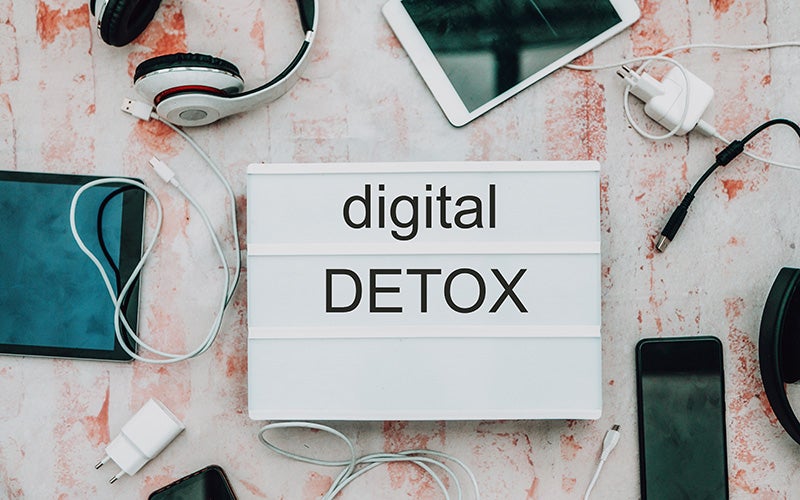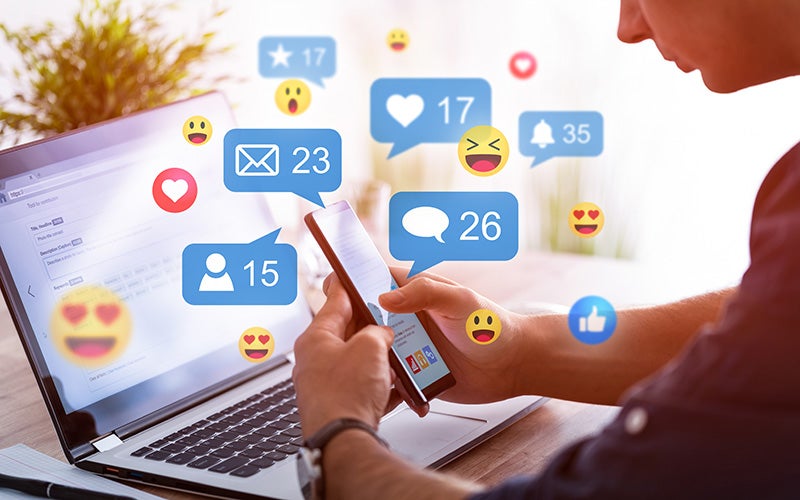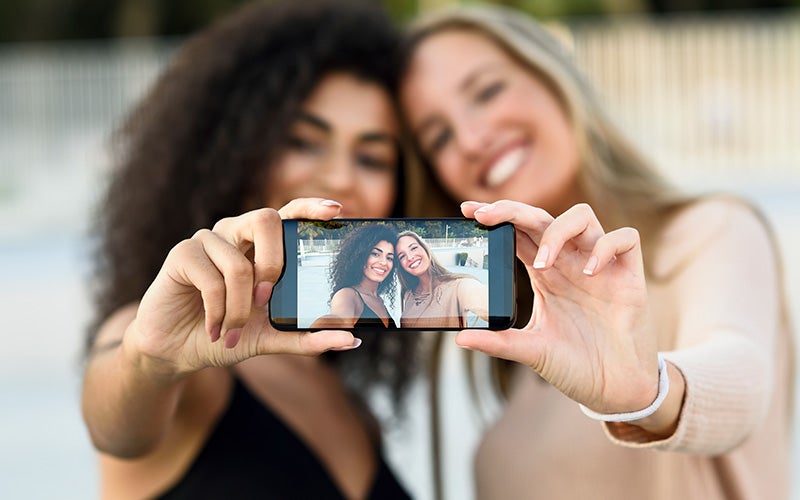Digital Detox: 12 tips for a more analog life
 '@Carol Yepes
'@Carol Yepes
There’s no time like the present to think about putting down your phone and unplugging your life. Going on a ‘digital detox’ is a big trend at the moment, and it’s not hard to understand why. Now more than ever, many of us are spending more time on our phones than we care to admit. If you feel like you’ve been seeing too many screens lately, intentionally cutting back might be just the antidote to your problem. Find out more about digital detoxing, and if it’s right for you, below.
What is a digital detox?
Digitally detoxing is all about taking a break from screens. You can do it for an hour, a day, or even an entire month depending on your intention and current circumstances.
While digitally detoxing, the aim is to limit or entirely eliminate the amount of time you spend on your phone or computer or watching TV. If you want to take it further, you can even cut out music streaming services, too.
The goal is to bring yourself back to the present moment – to step away from the stress of checking emails, doomscrolling, and responding to texts, and instead turn your attention to the physical world around you. That way, you are better able to devote yourself to your environment, the people you love, a good book (perhaps for World Book Day!), and even yourself.

Digital detox camps and retreats are having a moment right now because of the screen-free opportunity to relax that they offer. Integrating a digital or social media detox into your daily life is definitely not a walk in the park, but these programs will make it easier for you to log off.
In order to abandon screens, you need to change your habits. Many of us have a tendency to pull out our phones while waiting for the train, during a lull in a conversation, or whenever we’re not sure what else there is to do. Luckily, there are a few easy tricks you can use to cut back.
Is skipping screens worth it?
Smartphones, digital media, and permanent reachability are now a part of many of our daily lives. In many professions, they are even prerequisites for being able to work. In 2019, 76% of British citizens owned a smartphone.[1]
The use of smartphones has increased steadily over the years. Now, it’s reported that men and women spend roughly 1.5 to 2 hours on social media every day. [2]

The next time you find you’ve run out of time to cook or work out, consider how many minutes you spent scrolling on your cell phone.
Our tip: If you don’t have a lot of time on your hands to cook, there’s no need to stress. These 200 healthy recipes will all be ready in less than 15 minutes and have all the nutrients you need.
To be clear, digital detoxing isn’t about demonizing smartphones and TV. Quite the contrary. Technology has made it easier for us to live our lives and spanned so many opportunities for interconnectivity and personal growth. For the first time in history, knowledge is available 24/7 and at the touch of a finger.
But it’s important that we learn to utilize technology in a responsible way, the same way we do with so many other things. Our access to smartphones, tablets, and the like is relatively new, and unlike the children born now, (or “digital natives”) we adults did not grow up accustomed to having permanent access to the internet.

Research shows that push notifications, likes, and comments from social media use activates the brain’s reward system, increases self-esteem, and can result in addictive tendencies or a technology addiction. Furthermore, numerous studies have proven that there is a significant link between intensive technology use and how much stress and anxiety we feel.
Why do a digital detox? 5 reasons to consider disconnecting more often
The fear of missing something online is a reality for many. If the fact that your phone has less than 20% of battery power makes your heart flutter, and you find yourself constantly unlocking your phone for no particular reason, then it might be time to consider digitally detoxing. Here are some other reasons to give it a try.
Reason #1: You’ll be able to better concentrate.

Constantly switching from one digital medium to another can make it harder to focus on one thing at a time. Social media notifications and messages may distract you from your work. This may decrease your ability to concentrate in the long term and prevent you from being productive in the short term. And a lack of productivity may leave you unsatisfied. [3]
One study found that the mere presence of a smartphone in the room significantly decreases the ability to concentrate.[4]
Reason #2: You’ll have more time.

Check your screen time on your phone. How much time do you spend on your mobile phone each day? During a digital detox, you win all this time back to do whatever you want, whether that’s a walk in the woods, a book, quality time with friends, or for your favorite hobby. Now you have time for whatever you didn’t have time for before.
Reason #3: You’ll be able to better relax.
While digitally detoxing, you’re not supposed to respond to any messages, take any calls, or check any comments. You can simply enjoy the luxury of being fully in the moment. If you struggle with phone use, you might benefit from a meditation practice. And there’s no better time to give it a try than when you’re intentionally avoiding your mobile device!
Reason #4: It will improve your posture.

Endlessly scrolling through your phone may also lead to the development of long term issues, including problems with the neck, back, wrists, and eyes. [5] Time away from all that blue light might improve your sleep schedule, too. And your eyes will be better able to switch between near and far sight if you give them a chance to look out into the distance every once in a while.
Reason #5: You might feel happier.
Think about all the concerts, museums, and even restaurants that you’ve experienced through the lens of your smartphone. The moment occurred, but you watched it happen on a screen instead of right in front of you.
Researchers at the Ludwig-Maximilian University in Munich call this phenomenon “digital depression”. Happy moments are photographed instead of being savored, which keeps people from living them to the fullest. Digital detoxing gives you a chance to change that.[6]
12 tips to digitally detox on a daily basis
The nice thing about a digital detox is that you don’t have to cut yourself off entirely from your devices to reap the benefits. Logging off just once a day or week can be enough to improve physical and mental health in your everyday life. The goal is to cut down on unnecessary phone usage, even if that’s only a little bit. Use these tips to make it happen.
#1: Buy yourself an alarm clock
If scrolling before bed is a problem for you, this simple trick works wonders. With a separate alarm clock, there’ll be no need to even bring your phone or any other devices into the bedroom. Not only will that promote a night of restful sleep, but it will also start you on the right foot for waking up more relaxed and gradually to optimize your morning routine.
#2: Use airplane mode
When you need a break, simply take yourself offline. Not getting notifications will make it easier to forget your phone is there, even if it’s right in front of you.
#3: Block notifications
Each app is designed to grab your attention. Don’t let your time be wasted by random requests from your grandma to play Candy Crush. Disable notifications from anything that isn’t pertinent to your professional or personal life so it’s always easier to log off. You can always reactivate it later, but at least it will be your choice.
#4: Prioritize your contacts

Almost all smartphones have a “do not disturb” mode. It allows you to receive messages and calls, but doesn’t buzz or ring to notify you. However, if you want to receive certain calls even on do not disturb, simply make a list of favorite contacts who can always call and send you messages.
#5: Use digital detox apps
Today there are various applications that can make your digital detox easier. Install them and customize them to your needs. Or set a time limit for certain uses on certain devices and try to stick to it.
#6: Challenge yourself with your screen time data
Evaluating your amount of technology use can often be scary. But awareness is the first step to recovery. Each week, try to beat your record by spending less time on your devices than the week before.
#7: Give yourself the time you need and learn to be patient
Ever since read receipts arrived onto the scene, many of us have felt compelled to respond to messages as quickly as possible. But just because someone is expecting something from you does not mean that you have to react immediately. Give yourself the time you need to respond. And above all: give it to others as well. If something is urgent, don’t ignore it.
#8: Use out-of-office responses
In your emails and status updates, use an out-of-office reminder to let others know you’re not able to respond immediately.
#9: Keep private and work channels separate
When you’re having breakfast on the weekend with your family and friends and are surprised by a work email, you might forget that it’s your time to relax. Keep your work-life balance in mind, at least at certain times.
11 tips for a better work-life balance
#10: Define digital detox zones
It’s important to think about when and where you do and don’t want to be looking at a screen. Decide what hours or in which spaces you’re always going to sign off ahead of time so it’s easier to stick to.
#11: Find analog alternatives

Whenever a piece of digital technology is starting to bother you, consider whether there’s an analog alternative you can use instead. Try using a paper map instead of a GPS, or a film camera instead of the one on your phone.
#12: Identify your habits
When do you look at your phone or tablet or sit at the computer with no specific goal in mind? Identify these moments and decide to put the screen down and instead enjoy the moment you’re in. If you need a concrete alternative action, move around or inhale and exhale deeply several times.
Our conclusion
- A digital detox is very easy to integrate into your daily life.
- If you spend less time looking at screens, you have more time to live.
- Digital detoxes can benefit both physical and mental well being.
Sources for this article
We at foodspring use only high-quality sources, including peer-reviewed studies, to support the facts within our articles. Read our editorial policy to learn more about how we fact-check and keep our content accurate, reliable, and trustworthy.
- [1]https://de.statista.com/statistik/daten/studie/198959/umfrage/anzahl-der-smartphonenutzer-in-deutschland-seit-2010/ (Stand 15.09.2020)
- [2]https://www.bvdw.org/der-bvdw/news/detail/artikel/digitale-nutzung-in-deutschland-die-smartphone-nutzung-stieg-2019-werktags-um-14-prozent-an-am-woc/ (Stand 15.09.2020)
- [4] Adrian F. Ward, Kristen Duke, Ayelet Gneezy, and Maarten W. Bos: Brain Drain: The Mere Presence of One’s Own Smartphone Reduces Available Cognitive Capacity. IN Journal of the Association for Consumer Research 2017 2:2, 140-154.
- [5] https://www.thelancet.com/journals/lancet/article/PIIS0140-6736(14)60519-5/fulltext (Stand 15.09.2020)
- [6] https://www.uni-muenchen.de/aktuelles/medien/mum/artikel_mum/digital_erleben.html (Stand 15.09.2020)
- Adrian F. Ward, Kristen Duke, Ayelet Gneezy, and Maarten W. Bos: Brain Drain: The Mere Presence of One’s Own Smartphone Reduces Available Cognitive Capacity. In: Journal of the Association for Consumer Research 2017 2:2, 140-154
- Andrews S, Ellis DA, Shaw H, Piwek L (2015) Beyond Self-Report: Tools to Compare Estimated and Real-World Smartphone Use. PLoS ONE 10(10): e0139004. doi:10.1371/journal.pone.013900
- JIM-Studie 2019: Basisuntersuchung zum Medienumgang 12- 19-jähriger. Medienpädagogischer Forschungsverband Südwest.
- Markowetz, Alexander: Digitaler Burnout, Droemer Knaur, Oktober 2015.





























